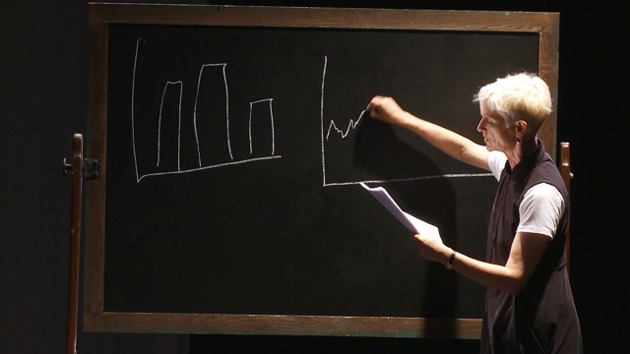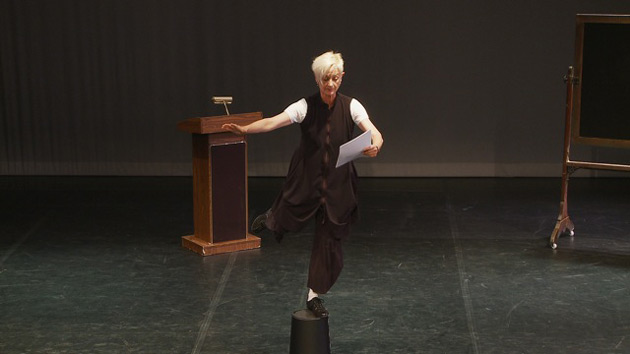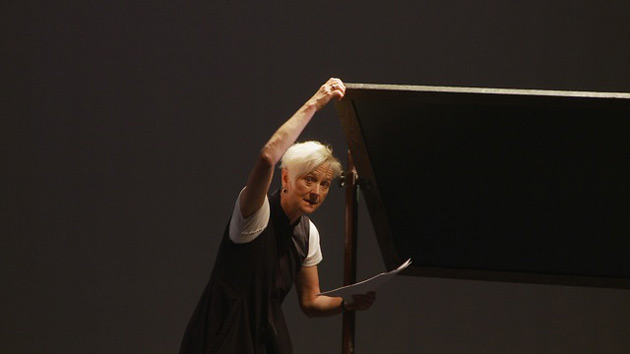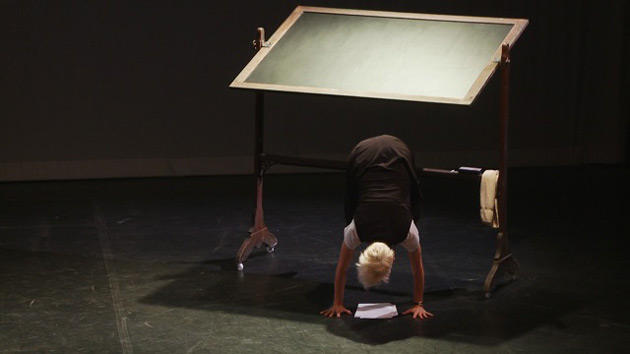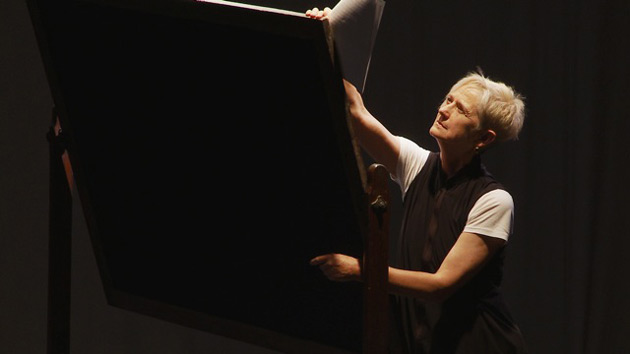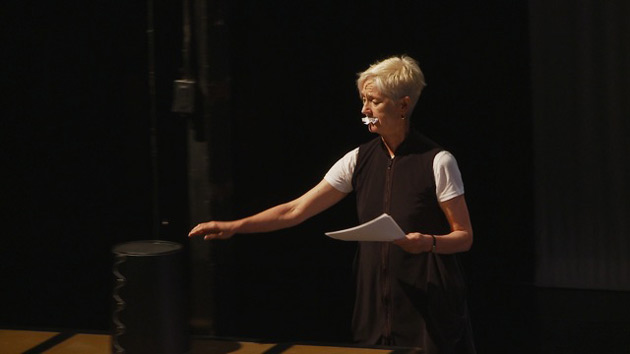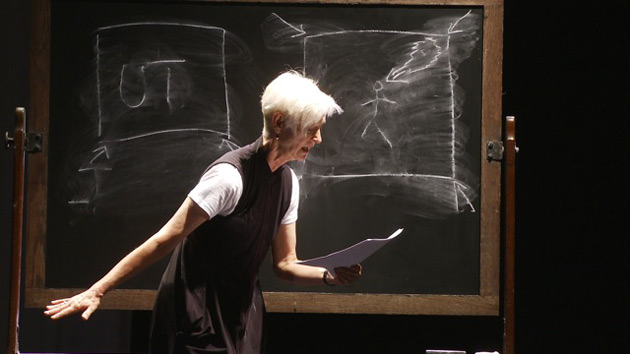Kinesthetic Empathies &
the Politics of Compassion
September 11, 2011
Reflections on “Kinesthetic Empathies & the Politics of Compassion”
by Dr. Linda Caruso Haviland
Editor’s note: Dr. Linda Caruso Haviland introduced each lecture prior to its performance by Dr. Susan Leigh Foster. Dr. Caruso Haviland was commissioned by The Pew Center for Arts & Heritage to write this series of commentary on each event and the discussions they engendered within in the context of Dr. Foster’s body of work. Unless otherwise noted, quotations are taken from the performed lecture. All images within the articles are stills extracted from the corresponding video unless otherwise noted, courtesy of Jorge Cousineau, 2012.
Lecture as dance

Flyer for “Kinesthetic Empathies and the Politics of Compassion,” performed during the 2011 Philadelphia Live Arts Festival on September 11, 2011.
As Foster creakily and haltingly plods across the stage, stooped and weighted by the persona of old age, she asks the audience to consider:
- How might another body witnessing this body imagine what it is feeling?
- How might the viewing body grasp the shuffling body’s sensations of tension, fatigue or achiness?
- How might the viewing body fathom the motivation, desire, or emotion contained within or is it attached to this slumping figure?
All of which leads to the key questions for this evening’s lecture: How and “on what basis might the viewing body claim to apprehend what the moving body is experiencing?”
Returning to ‘normal’ posture, Foster picks up a bucket of sorts, although far more modern and chic than my description suggests, flips it upside down and steps up to balance neatly, two feet on a small surface.
To answer her questions, she turns to Monsieur Chevalier Louis de Jaucourt’s entry in Denis Diderot’s Encyclopédie, ou dictionnaire raisonné des sciences, des arts et des métiers, Note 1 in which he describes the “very erect and spectacular body” of the 18th-century tightrope dancer and suggests that studying this body’s performance “offers an unusual sense of identification with the dancing body because of its treacherous and suspenseful relationship to gravity…and the potential hazards that may befall it.”
Even as she speaks, these potential hazards play out before us. We see all the visible effects of a person struggling to maintain her balance as Foster recalibrates her position on the bucket—nearly on, nearly off—risking her balance on the edges of the bucket, then on one foot, and finally finding a more secure perch. These experiments with balance will return in the course of the lecture. Note 2
Jaucourt proposed that it is a situational dynamic between the dancer and the viewer, or a reading of the scene taken as a whole which produces the empathetic response. Voicing Jaucourt, Foster instructs that in observing the dancer’s precarious positioning, “the viewer experiences the stirring up of emotions that instinctually arises when we see those like ourselves in peril.”
She ‘falls’ off of the step.
Citing Adam Smith, an 18th-century social philosopher and proto-economist, Note 3 Foster further clarifies Jaucourt’s speculations about empathy. In his Theory of Moral Sentiments (1759), Smith concurred that we can never truly know or experience the feelings of another person; he supposed that, instead, “By the imagination we place ourselves in his situation, …we enter as it were into his body, …and thence form some idea of his sensations, and even feel something which, though weaker in degree, is not altogether unlike them.” Interpreting Smith for the audience, Foster explains that “should the dancer fall, the actual physical experience of pain is not accessible to the observer to any significant degree…rather, the circumstances in which the pain is endured form the basis for imagining the other’s plight.” But ever vigilant to the socio-cultural conditionings of doing and seeing movement, Foster picks up on Smith’s note that ‘circumstances’ include the social as well as the physical. She returns to her stooped, shuffling walk, addressing Smith’s implications in bodied terms. Is Foster acting an old woman or a beggar? Would our “degree and kind of empathy be different based on all the clues signaling her identity?”
Skipping two centuries, Foster next focuses on another theory of empathy, this one proffered by John Martin, the pioneering American dance critic and early champion of new forms of modern dance, whose writings first appeared in the New York Times in 1927. Summarizing Martin for us, she explains his belief that “viewers comprehend the meaning of a dance through their capacity for inner mimicry.” Upon viewing another person, Martin suggested, our kinesthetic senses kick in and we mimic in the musculature and nerves of our own bodies, sometimes imperceptibly, the physical actions and sensations of the body that we see before us.
She drags first one fingernail and then all five with great deliberateness along a chalkboard that has been stationed stage left and as many in the audience shake off the involuntary shudders they experienced, Foster reminds us of other familiar bodily responses—puckering up when we witness someone tasting lemons or yawning when a person near us yawns.
She tilts the blackboard horizontally and creeps along beneath what now suggests a “ceiling,’’ and then climbs through the frame of the blackboard, pikes towards the floor, head first, and jiggles the board with her feet.
As surrogate for Martin, she informs us that objects, as well as bodies and events, can “elicit this kinesthetic responsiveness” and argues, in his words, that “in walking through a building we sense its verticality and mass, the openness or closeness of it spaces.” Following this, Martin argued that if we respond kinesthetically to natural or constructed objects, would we not more so “respond vigorously to the action of a body exactly like our own”?
She dismounts, slides her arm between the blackboard and its frame, and tilts the blackboard back towards the frame, squeezing her arm in the process.
In the audience, we wince at what we imagine to be the discomfort produced by Foster’s arm caught in that vise, and she capitalizes on this moment to introduce more of Martin’s ideas about empathy. Building on early 20th-century philosophical and psychological theories, Martin claimed that, since human bodily responses were linked to human emotional states, our kinesthetic responses to watching another human move or dance should generate emotional responses as well. And not just any emotional response. These theories posited that there was a sort of universal reservoir containing emotions and the particular ways in which these emotions were expressed and that these were common to all humans. In a successful empathetic relationship, he asserted, the viewer muscularly mimicked the dancer’s actions and thus experienced, as well, those emotions that the dancer was expressing. But as these actions were intentionally constructed by the choreographer who was selectively drawing on this shared cache of emotional expression, the dancer, and thus the viewer, were recognizing and sharing the exact same emotion as the choreographer.
She walks back to the audience and begins a movement phrase that will reappear throughout the lecture, conveying meanings that will change, depending on the relationship of the phrase to the text she is reading aloud at that moment. In this first instantiation, each segment is repeated two or three times.
“Viewers’ bodies…even in their seated stillness nonetheless feel…
she lunges and pushes her arm strongly towards the audience
…what the dancing body is feeling—the tension or the expansiveness, floating or driving momentums that compose the dancer’s motions…
she kicks her right leg briskly front and across her body, with her right arm sweeping circularly with the same impulse and rhythm
…and then, because such muscular sensations are inextricably linked to emotions the viewer also feels the choreographer’s desires and intentions.”
she vigorously treads in place, feet parallel and a short distance apart
Foster indicates the similarities between the 18th-century Jaucourt and 20th-century Martin—both presume “a spontaneous and mechanical connection between the viewer’s perceptions of and feeling about the dancing body”—and the differences: Jaucourt’s empathy arises from the “logic of the scene” while Martin’s arises from a biologically and psychologically “intrinsic intertwining of muscular action and emotion.”
She picks up the bucket, places it on table at stage right, steps up on it, balancing in front of a structural pillar in the space. Again, precariousness made visible
Dismounting, she begins to dance vigorously, repeating a variation of the earlier movement sequence but now eliding each gestural phrase into the other
She continues to dance and to clarify. Martin’s hypothetical dancer, whether or not she or he is the choreographer, “has learned to perform choreography devised during the choreographer’s creative process of investigating movement’s emotional meaning.” Because meaning and movement are intrinsically connected for Martin, what the choreographer feels is passed on to the dancer who, in turn, transmits it to us.
Her movement slowing, she ends in a lunge and reaches towards the audience
Jaucourt, on the other hand, did not insist that viewer share the tightrope dancer’s emotional state. The audience, explains Foster, may experience a “shiver of alarm” at the threat of her losing her balance, but the dancer’s emotional state at that moment may be completely comprised of feelings that are necessitated by the very practical maneuvers of regaining her balance. Jaucourt’s version of empathy does not preclude speech, but, returning to her arguments against the muteness of dance, Foster points out that Martin’s transfer happens on what he takes to be a deeply biological level and “almost requires that speech has ceased.”
She rips up her lecture notes and stuffs them into her mouth, trying to continue to argue but barely able to communicate the sense of her words…something about the ability of reading out loud to undermine longstanding dichotomies between language/speaking and moving/feeling. She walks to the table, flips the bucket over, and spits the papers into it.
“Both Jaucourt and Martin made their claims for empathetic physicality in order to rationalize a universal capacity for human understanding across racial, class, and cultural barriers.” Jacourt’s claims for this capacity were based on the “irrefutable” physical facts and social dynamics of the situation that all would understand, and to which all would respond in a similar manner. He supposed, for example, that categories such as falling, safety, and danger were recognizable in the same way across time and cultures. Martin, similarly, insisted on dance as a universal language emanating from a common experiential core that characterized human existence; but in his case, what we shared was the “universal psychological variables upon which all human interaction is based.”
In a manner that exemplifies best lecture practices, Foster expounds more fully on the theories of Jaucourt and Martin, methodically outlining details on the blackboard and diligently sketching charts and graphs. But this familiar academic scene is then upended as she proceeds to erase the board with her face.
Then Foster, in her best scholarly voice, warns us that “claims for a universality of psychological or physical experience have in more recent years been critically interrogated from several complementary perspectives, specifically those of gender, postcolonial, and critical race studies,” revealing the differential of power at play in each perspective, and making “evident the political role of all those who perform in empathy’s scenarios.” The working-class venue of Jaucourt’s tightrope dancer and the racial minstrelsy of Martha Graham’s and Helen Tamiris’s Americana works are not, she suggests, merely coincidental contexts.
Foster slowly climbs into the audience, allowing herself to be shifted, supported, passed along, as in some gentle mosh pit, among audience members willing to participate.
Here, again, we arrive at a balancing act: critical inquiries have, as Foster says, provided “invaluable techniques” for revealing and examining the historical and unique, particular nature of our experience; but, she insists, they must also continue to consider “the nature and constitution of what is shared in experience.”
Keeping in mind the problems generated by embracing notions of universal human conditions or states, while at the same time probing the possibilities of shared and even empathetic relationships, Foster asks what it is that scholars, critics, dancers, choreographers, and other viewers can claim about what is felt or what transpires while watching a dance, now or in the past, here or afar. She wonders:
- Is there any framework within which to affirm a located and partial understanding yielded up in the empathetic moment of witnessing another body?
- Are there ways in which a shared physical semiosis Note 4 might enable bodies in all their historical and cultural specificity to commune one with another?
- Are there techniques of knowledge production that invite us to imagine the other without presuming knowledge of the other?
- Are there techniques that do not rely on the body to represent a moral self or ethical stance but that allow the body to convey a message concerning itself?
The stage is a wreck. The podium and blackboard are upended, papers strewn about. Whether this is annihilation of the old or simply chaos, is it possible to imagine something new arising out of the mess?
Foster answers her own questions by proposing another theoretical model of empathy, this one grounded in the process of learning to dance, wherein “there is an apprehension of how bodies are both same and different from each other.” She asks for volunteers and 12 game audience members join her onstage in an exercise of mirroring her movements and gestures as she continues to speak.
Foster frames her thesis by returning to an argument she had put forth in her second performed lecture. Moving from the relationship between writing and dancing to the relationship between bodies, she states that they are “both alike and different from each other.” She suggests that in copying another’s movement in dance class we learn “what the appearance of another’s body feels like.” We can only see the other body but within our bodies, uniquely standing in our individual and particular islands of space, we both “feel and see [our] own bodies replicate the action” of that body over there. Shaping our self like the other, moving like the other, we are simultaneously and distinctly moving as our self and not as our self, but as the other. While never really knowing the other we, nevertheless, perceive and sense and share the other’s living moments in motion. We can never perfectly reproduce the other but we can “create mutual awareness through the willingness of two differentiated bodies laboring together at the impossible task of approximating one another.”
The volunteers now mirror each other in pairs. They start out somewhat timidly in static spatial territories, but before long they are exploring a full range of gestural and spatial possibilities, and the stage space is palpably charged by that exploration.
The various modes of learning to dance—through touch, example, verbal description, physical and verbal metaphors—situate our common human physiology in the more particular “social and cultural worlds that we inhabit.” These modes are formed by and give form to the specific worlds that we share, which are both like and different from other possible socio-cultural and historical worlds.
For Foster the most important thing that dancing teaches is “our similarities and differences one to another,” which she wants to “conceptualize as a decision, a political decision—the choice to affiliate with either sameness or difference to the exclusion of the other.” Committing to a belief about the nature and practice of empathy is never based on purely physiological processes or neutral abstracts like “space” and “time.” A discourse of “sameness” that “united all instances of human movement” was what justified, for example, positing the white body as the universal body in countless performances on stage or in film. A discourse of “sameness” can reinforce power structures and create populations of ‘others.’
Foster also cautions that discourses that “focus only on the individual and the uniqueness of each person’s experience of dance are equally problematic in that they discourage any possible understanding and, consequently, any shared possibility for coalition building.” And, she says, the “choice towards sameness, denying difference” or “towards difference, denying commonality” is never fully consciously or freely chosen in unmediated ways; these choices are often shaped beneath the level of any conscious awareness of their constructed nature and always respond to the “political exigencies of the social.” Theories of empathy and the empathetic response may, in fact, as she discusses later in the Q & A, have a physiological base. Yet they are, as well, socially, culturally, and historically structured, and this structuring can be used “to rationalize the workings of power,” in art and in life.
Foster summarizes her intentions in making and performing this lecture about the nature, construction, and operation of frameworks of empathy and compassion. She has, she explains, “tried here to point to the differentials of power built into these moves and to the distinctiveness of their historical movement” and to suggest that despite any biological factors, “the empathetic response to a body’s plight is structured in historically specific ways to accommodate varieties of sameness that serve to rationalize the workings of power.” Foster returns to dance as both a potentially liberating and subversive activity. She reiterates the ability of dance to evoke multiple and simultaneous frameworks for understanding difference and sameness, and the potential impact of a dancer honing her ability to “think on her feet,” enabling her to “evoke these frameworks while learning the dance of another.” Extrapolating these skills, practices, and awarenesses from the studio or stage into the world, we might, Foster hopes, “sense how power moves, when it consolidates, and where it disperses.”
She and the volunteers face the audience. She repeats the movement phrase that has reappeared in different contexts and variations throughout the lecture. The audience mirrors her as she voices and physically performs each gesture:
Push
Kick
Jog
Run in a tiny circle
Jump
Get close to someone
Reach
Duck
Balance
Lunge/reach
Stumble
Face
Stand
Dart around
Grab someone’s hand
She offers a possibility: “if we just could think on our feet in these ways that just might help us to choreograph resistances to power as it moves.”
Together Foster, her group of volunteers, and the entire audience repeat the phrase that she now overlays with this narrative:
| Push | When to give power a push or |
| Kick | a kick |
| Jog | When to persist in a routine action |
| Run in | How to circumnavigate around or a tiny circle |
| Jump | leap across its massing of weight |
| Get close | How to congregate precipitously to someone |
| Reach | How to stretch |
| Duck | or duck |
| Balance | or strike a balance |
| Lunge/reach | When to reach |
| Stumble | stumble or |
| Make a Face | imposture |
| Stand | Where to stand defiantly |
| Dart around | or run deviantly |
| Grab someone’s hand | How to grab another’s hand |
“Quite a justification for a dance class, isn’t it?”
The Q & A
This final lecture was included as part of the Philadelphia Live Arts Festival & Philly Fringe, and the capacity audience extended beyond the usual cohort of dancers, choreographers, critics, and scholars.
As in the prior Q & A sessions, people were curious about Foster’s process. In this case, after owning up to an “obsession” with empathy that had materialized in an essay and a book, Foster explained that this particular performed lecture had been developed specifically for the occasion, and that she had simultaneously written and planned what she would be doing. “Eating” her lecture arose from that joint process, but other moments were inspired from outside—for example, the use of blackboards in MIT online classes. But her strategy here as in the other performed lectures was the play of language and gesture, the effort towards making evident the “multiple meaningness” of the props, the language and the gestures as they played off of each other differently at different places within the performance.
Several in the audience were interested in other audiences’ responses to the gesture and physicality of the lectures, and Foster reiterated that she has performed lectures such as these in other contexts, generally academic, in which attendees literally got up and moved to “safer seats” in the back. But although Foster wants to destabilize the disembodied stances of ‘talking heads,’ she was not interested in pressing resistant audience members to participate. She tries “to respect their boundaries and not put them on the spot”; instead, she looks in the audience for those who seem “more game, ready to go, and playful.”
Did Foster’s observation and weighing of potential audience response constitute an act or state of empathy? From the questions that the audience posed, it was clear that they were still wrestling with the possible meanings and functions of empathy. One questioner puzzled over abstract dance and art in which there are fewer recognizable human emotions or no story with which a viewer can identify. How does empathy operate in this situation? Another mused that if empathy is characterized as a kinesthetic connection that is benevolent, can there also be a sort of negative empathy, a “kinesthetic revulsion or repulsion?”
Foster replied that it wasn’t her intention to state how she thought empathy worked in these various situations but, rather, to make us aware that empathy, above and beyond any physiological basis, is a learned response that is framed differently through time and across cultures. In her words, she is interested in “how in different historical moments the technologies surrounding the framing of the kinesthetic connection and the empathetic connection that we feel one to another have changed and the very underlying premises of that have changed.” How do we learn to feel towards one another? Towards whom? When, and in what situations?
As always, with Foster, these questions have important political implications. For example, when queried about the media’s ability to present situations from afar that might provoke an empathetic response, Foster agreed that this could expand and extend our empathetic capacities from the personal to the global. But, she hastened to challenge, what is the effect of switching from images that provoke deep empathy to commercials pushing consumerism? Should we not at least question this as “another set of framing devices…that build up and then redirect empathy?”
There were, as well, interesting responses from among the night’s audience members who worked in arts outside of dance. One young man who identified himself as coming from theater explained his context for viewing in which the experience of empathizing with those on stage came from his location beyond the arena of action. The act of a dancer coming into the audience, touching him, which he characterized as feeling like a sort of a violent attack on an expectation of empathy, disrupted his usual processes of watching, seeing, reflecting, and identifying. When that happened, the distinction he could make between what is performed and what is real collapsed. With reference to Foster’s utilization of the group mirror improvisation and use of that mirroring to demonstrate her claims about the mutual experience of sameness/difference, another audience member coming from the visual arts noted that in her field, the mirror has held a very negative connotation, suggesting narcissism. She then cited that the process of generating ourselves endlessly in social media outlets operated as yet another kind of mirroring that reinforced mirroring as a conceptual site of self-infatuation. But she admitted that, after having watched the volunteers who came into the performance, she was now interested in “reappropriating this more positive notion of mirroring” into visual arts and for a more general audience.
Foster did admit that there were similar problematic uses of the mirror in dance. In the dance studio, for instance, we can become narcissistically obsessed with our own image. Yet in the mirroring exercise, she pointed out, we substitute another’s live body for our own image—a fundamental difference from looking at ourselves in the mirror. The exercise teaches us that in striving to move exactly like our partner, we learn “what the appearance of another’s body feels like.” At the same time, however, the impossibility of perfectly mimicking what we see in another teaches us about the differences between ourselves and that other.
But, again, the personal is always the political. When asked about her earlier statement that no one can perfectly repeat the movement or gesture of another, Foster revealed that in considering the impossibility of perfect mirroring, she became aware that “people who claim either an underlying sameness or an underlying difference are always making a political claim. They’re making the claim on the part of one group of people for all people.” The ability to work towards a mutual experience of sameness and difference, which is what happens in every dance class, is quite different from demanding that one stand on one side or the other of the claims for universal sameness or for exclusionary difference.
In claiming this power for dance, she is, in fact, revealing her preference for defining empathy as a response that undermines the binary of choosing between either sameness or difference. The mutual working together towards moving like the other, feeling to some degree what the other moves like, while simultaneously recognizing each one’s own distinctiveness in the process, opens up a constantly shifting and evolving state in which we experience and can potentially accept sameness and difference at the same time. This is a politics of tolerance and inclusion that retains the integrity of the individual through a mutual, though not always easy, acknowledgement of both possibilities.
The questions and responses of the audience indicated that a constantly shifting landscape of give and take, like and unlike, single truth and multiple interpretations, shared and distinct, can be experienced as liberatory or as anxiety provoking. So in response to a question about the relationship between empathy and cultural appropriation, Foster, again, cautions against the pursuit of certainty: “Cultural appropriation always occurs when people feel like they ‘got’ it,” in the sense of completely understanding it, or that it was there for the taking and they did. An empathetic response that, instead, promotes a commitment towards learning to move like the other, to feel how the other moves, while knowing at the same time that one can never completely know, duplicate, or colonize the other, is a process that has no final and certain endpoint of “getting it.” It is an “ongoing process of learning” that takes work but that has the potential to encourage “continuing dialogue and exchange.”
On the other hand, another audience member voiced the discomfort, one that she suspected many shared, about living with this tension—between yearning for a universal capacity for empathy versus knowing that we can never truly know what another feels. Was Foster suggesting that the experience of learning to dance could actually teach us to tolerate this state? “Absolutely!” Foster voiced in reply. To its capacity for enabling mutual and simultaneous sharing of the experience of sameness and difference, she noted that learning to dance required not only moving but thinking about movement (“how we are moving, that we are moving, why we are moving”) and further reflection “on the fact that we are experiencing those things.” The experiential and the analytic or making sense of those experiences are part of what “constitutes dance education.” By implication, furthermore, dance education enables us to experience and reflect on our frameworks for defining, evaluating and experiencing empathy.
The last question of the evening came from a dance therapist who cited the need to be able to “understand and empathize with a person psychologically” as part of the therapeutic process and asked whether Foster’s work was interfacing with some of the newer theory on mirror neurons that was emerging from neurobiological research. Foster expressed her excitement about this work and about the fact that neuroscience was finally attending to experiences and behavior that had already been recognized in dance and dance studies.
However, Foster finished with the same caveat with which she began—that empathy is, in part, a learned response and that she is pressing the importance of asking and answering the question of how we learn to feel towards and about one another. What are the metaphors that scientists, or others, use in describing the fundamental conditions of human behavior and interaction and—the implications are left unstated—who benefits and what are the payoffs for particular framings of our humanness? “When all is said and done,” she reminds us, there is always “the need to employ a metaphor to describe what they are looking at…and metaphors have political consequences.”
Endnotes
- Chevalier Louis de Jaucourt (1704–79) was a French scholar who had studied theology, mathematics, the natural sciences and medicine. He wrote nearly a quarter of the articles that comprised the great eighteenth century French Encyclopedia. The Encyclopédie, ou dictionnaire raisonné des sciences, des arts et des métiers (Encyclopedia or a Systematic Dictionary of the Sciences, Arts and Crafts) was published between 1751 and 1772 in 28 volumes. Edited by Denis Diderot and Jean le Rond d’Alembert, the collection of over 70,000 informational articles, essays, and illustrations included contributions by various writers on topics ranging from mathematics to natural history, mechanical sciences to music, philosophy to trade, and, importantly, dance and dancing masters. In both its exhaustive content and systematic form it is considered an important representation of Enlightenment thought. Back to article
- Italicized sections present the author’s perception of and commentary on Foster’s movement, gesture, and choreography which, throughout the performed lecture, were interwoven with the delivery of the read text. Back to article
- Scottish philosopher Adam Smith (1723–90), along with philosopher David Hume and others, is a significant figure of the Scottish Enlightenment. His most famous book, The Wealth of Nations (1776), is often considered the first work of modern economics; it is in this book that he uses the idea of the “invisible hand” of the market. But Smith wrote on a multitude of other topics, including the social philosophy of emotions and ethics. Back to article
- Definitions vary but semiotics or semiology is generally taken to mean the study of signs and sign processes within a social context and a network of signification and meaning in language. Semiosis is a sign process; it is the interaction among the sign, its referent, and its interpretants that generates meaning or significance. Back to article




